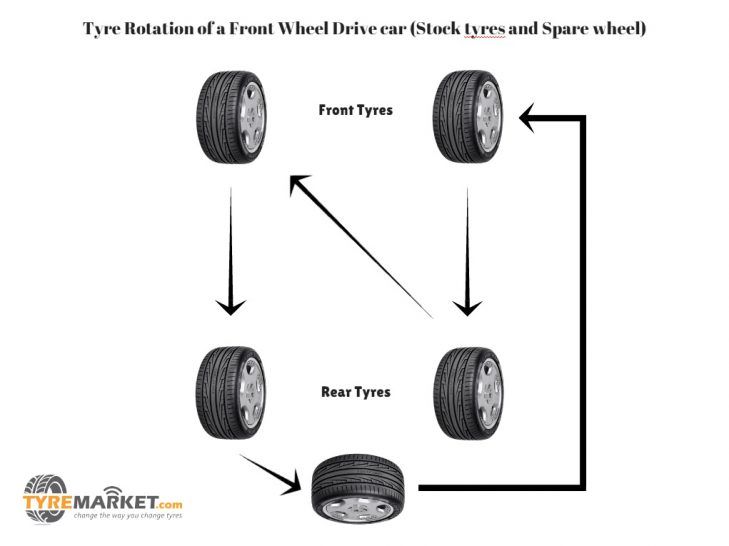Share
With this crummy economy, we’re all looking for ways to save money. One way to save a few bucks is doing your own auto maintenance. We’ve already discussed how to change your own oil. Today we’re going to tackle another maintenance job that you can easily do yourself.
If you’re not careful, your car’s tires can become a big money pit. Tires aren’t cheap. A new one can set you back at least $80. If you go through a new set of tires every year, you’re looking at dropping at least $400. Boo.
One simple way you can extend the life of your tires is regularly rotating them on your car. Tire rotation means changing where the individual tire is mounted on the car. Some men don’t ever have their tires rotated, and those that do usually let a quick lube take care of it. But this simple 15 minute job will set them back at least $20 at most places. Save yourself the money by doing it yourself. In today’s post we show you how.
Front and rear tires wear differently. For example, the front tires carry more than 60% of your car’s weight; consequently, front tires wear down faster than the rear ones. Also, turning wears the front tires at different rates. In America, we generally take left turns faster than we do right turns. This puts more load on the right front tire which results in the right tire wearing faster than your left. After thousands of miles of driving, you end up with uneven tread wear.
Rotating tires equalizes these natural wear patterns by changing the positions of your tires. By rotating your tires regularly, you’ll ensure yourself a smoother and safer ride. And more importantly (for me at least) you’ll save money in the long run by extending the life of your tires.
Oh, and it feels manly to flip tires around, too.
Check your car’s owner’s manual for the recommended tire rotation schedule. Most manufacturers recommend that you rotate your tires every 5,000 miles.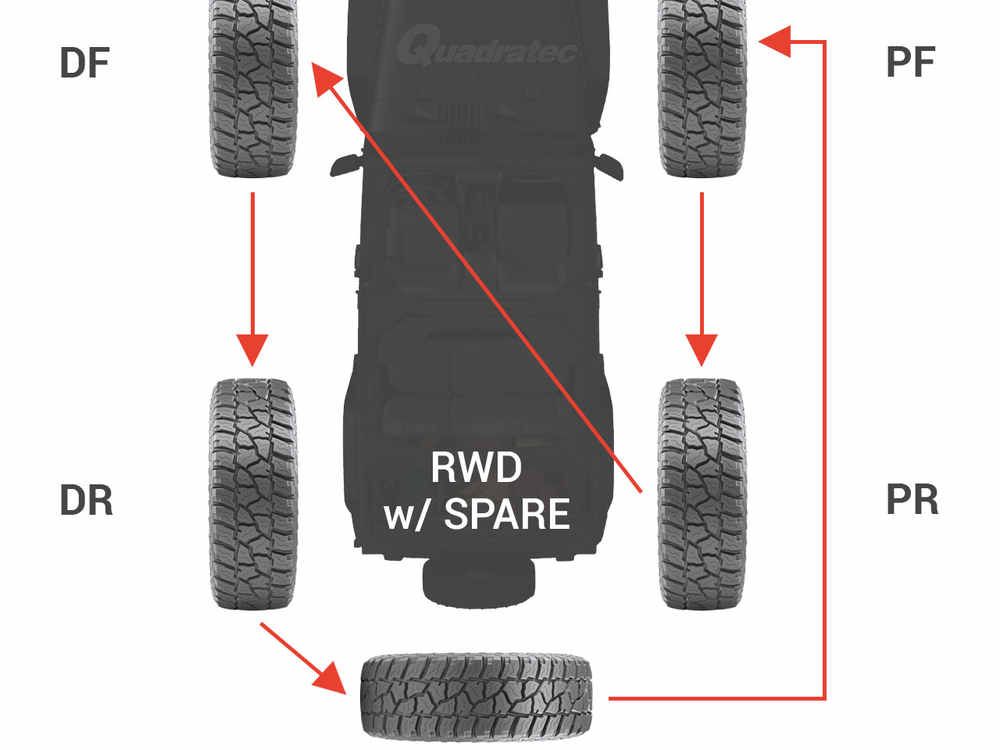 An easy way to remember to rotate your tires is to do it whenever you change the oil on your car.
An easy way to remember to rotate your tires is to do it whenever you change the oil on your car.
Car jack. Using the jack that comes with your car can work, but it isn’t recommended for rotating your tires. It’s designed to lift up your car for a short amount of time so you can quickly change a tire. The safer route is to use a hydraulic floor jack. A good floor jack will set you back about $100, but your safety is well well worth the investment. A car jack will come in handy for other maintenance jobs as well.
Jack stands. You’ll need some jack stands so you can rest the car on top of them while you switch the tires out. You can buy a decent set of jack stands for about $30.
If you don’t want to fork over the dough, you can jerry rig a jack stand with a cinderblock and a two by four. Just place the cinderblock under a wheel and place the two by four on top of the cinderblock to prevent scratching the bottom of your car. Lower the car jack so the car rests on the cinderblock and two by four. Wala! Instant jack stands!
Lower the car jack so the car rests on the cinderblock and two by four. Wala! Instant jack stands!
Before we start loosening those lug nuts, we need to know what pattern we’re going to use to rotate our tires. The way you rotate your tires depends on a few factors, the biggest one being whether your car has directional or non-directional tires.
How to Rotate Directional Tires. Directional tires have a “one-way” tread pattern that are optimized for the direction the tires rotate on the car, so they’re specifically made for either the left or right side. The grooves are angled to optimize handling, and they also do a good job of channeling water out from under the tire on wet surfaces, reducing hydroplaning and improving wet traction.
Little arrows or triangles on the sidewall indicate which way the tire is supposed to turn.
To rotate directional tires, just switch the front right tire for the back right tire, and the front left tire for the back left tire, like this:
How to Rotate Non-directional Tires.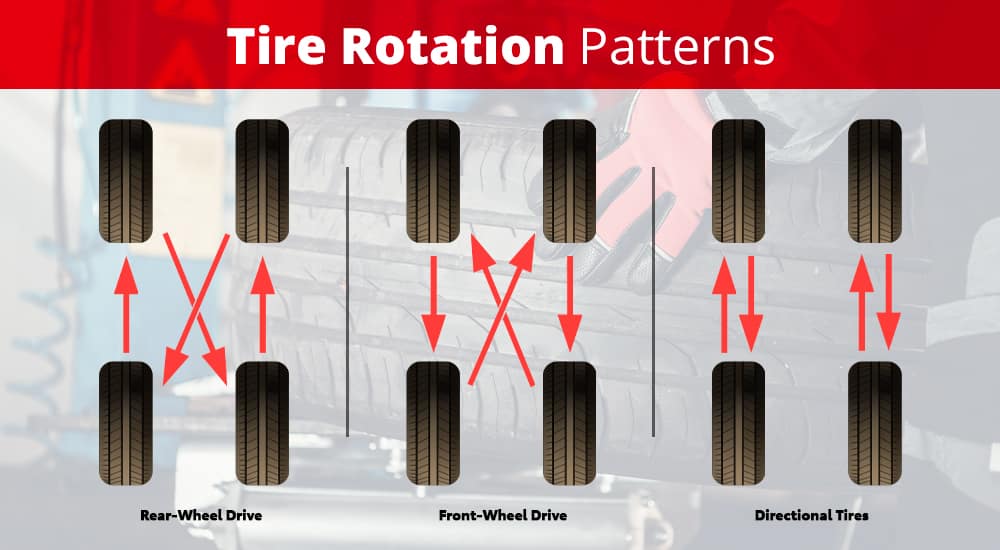 The tread pattern on non-directional tires is designed in such a way that the tire can be mounted on the wheel for any direction of rotation. So you can switch which side the tires are on when you rotate them.
The tread pattern on non-directional tires is designed in such a way that the tire can be mounted on the wheel for any direction of rotation. So you can switch which side the tires are on when you rotate them.
To rotate non-directional tires, use the cross pattern. For cars with rear-wheel drive, move the front tires to the opposite sides of the rear: left-front to right-rear and right-front to left-rear. The rear tires are moved straight forward. Here’s how it looks visually:
On vehicles with front-wheel drive, just do the opposite. Move the rear tires to the opposite sides of the front and move the front tires straight back.
Some old car maintenance guides recommend that drivers rotate their spare tire into use in order to give one of the tires a much needed break. The problem with this advice is that the vast majority of modern spare tires aren’t designed for extended driving. They’re often smaller and feature a lighter-weight construction and shallower tread depth.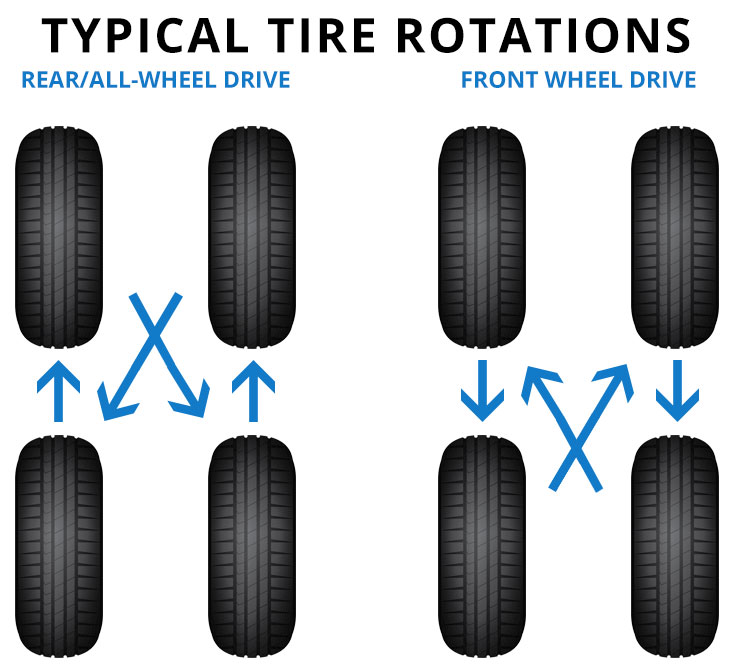 They’re designed to simply get you to a shop to fix the original tire. That’s it.
They’re designed to simply get you to a shop to fix the original tire. That’s it.
Some cars still come equipped with full-size matching spare tires. Off road vehicles and many SUVs usually have them. If you have a car that has a matching spare tire, it isn’t a bad idea to rotate it into use. Here’s a diagram for the suggested rotation:
Time needed: 20 minutes.
1. Engage parking brake. Just for your safety.
2. Loosen the lug nuts on all your wheels. You don’t want to take them completely off yet. Loosening them now will make unscrewing them when the car is elevated much easier.
3. Lift up one wheel with car jack and place jack stand underneath it. If you just have one or two jack stands (or cinder blocks) you’ll need to do a bit of mental work before you start jacking so you know how you’re going to proceed with lowering and raising your car. Because you have fewer stands, you’ll also spend more time lowering and raising your car in order to switch them out.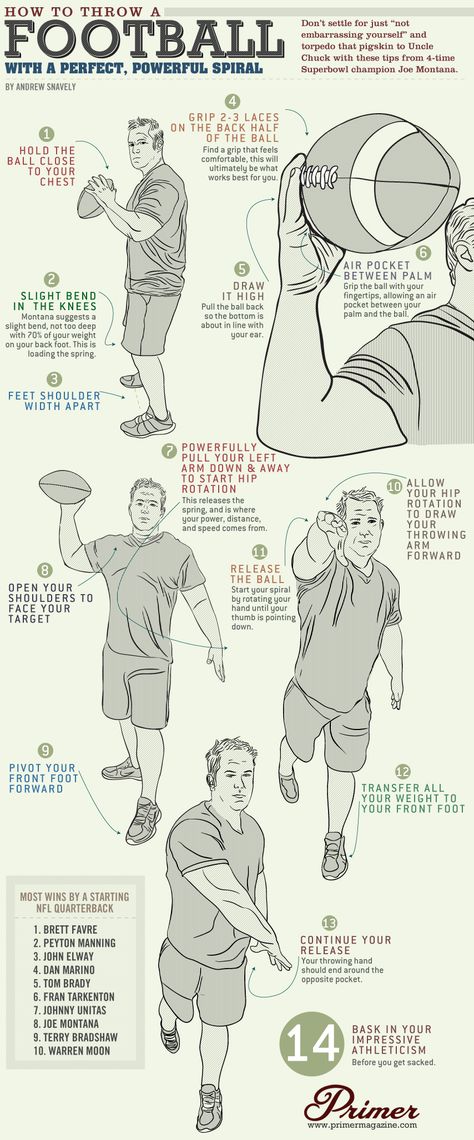 Despite the extra effort, you still won’t spend much more than 20 minutes on the job. I’ve seen some people place their car on all four jack stands. It’s not exactly the safest thing to do, but it will definitely help you get the job done faster because you don’t have to switch out jack stands.
Despite the extra effort, you still won’t spend much more than 20 minutes on the job. I’ve seen some people place their car on all four jack stands. It’s not exactly the safest thing to do, but it will definitely help you get the job done faster because you don’t have to switch out jack stands.
4. Remove the tires and rotate them according to the appropriate pattern for your type of tires. When you place a tire back onto the wheel mount, screw the lug nuts on by hand as much as you can.
5. Lower the car from the jack stands. Take the lug wrench and tighten the nuts even more. It’s best to work the lug nuts diagonally from one to another. It looks like a star pattern. This ensures even tightening. Tightening the lug nuts unevenly can warp the brake rotor.
Star pattern when tightening lug nuts
That’s it! Now just mark down the mileage when you rotated your tires and remember to do it again in another 5,000 miles.
Tags: Cars
PreviousNextHow-To Guide
Posted on: September 17th, 2019
Taking off the lugs of the vehicle's tiresTo compensate for uneven wear and tear on your tires, regular tire rotation is important. Your front tires carry about 60% of your vehicle’s weight and are more likely to feel hard turns, therefore they wear out more quickly than your rear tires. By rotating your tires regularly, you will even out the tread wear that comes with daily driving and prolong the life of your tires. Generally, tires should be rotated every 5,000 miles; consult your owner’s manual to see if it provides a recommended tire rotation schedule.
Identify the possible rotation pattern for your vehicle, which will be based on the type of tires you have as well as whether your vehicle is front or rear wheel drive.
Loosen the lug nuts of all the wheels but don’t remove them yet.
Jack up your car and use jack stands to support the vehicle. Consult your owner’s manual to determine the proper placement of the jacks.
Remove the tires and rotate them according to the correct pattern for your tire type.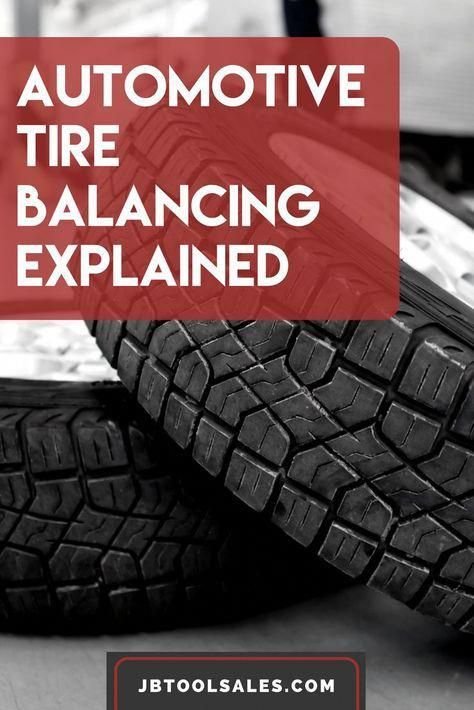
As you place each tire in its new position, screw in the lug nuts by hand as much as you can.
Raise up your vehicle using your jack and remove the jack stands. Then safely lower your car back down.
Finally, use the lug wrench to fully tighten the lug nuts of each tire. Tighten diagonally, in a star pattern to ensure even tightening. If you tighten them unevenly, you run the risk of warping the brake rotor.
Share This Article
Top Related Articles
More How-to Guides and Articles
Changing shoes is the hottest topic for motorists during the off-season. In spring and autumn, queues traditionally line up at tire fitting points. But not everyone wants to participate in this ritual: having collected a second set of tires and wheels, many car owners change the wheels themselves. Let's talk about how to do it right - especially since every driver has to change a wheel on the road sooner or later.
But not everyone wants to participate in this ritual: having collected a second set of tires and wheels, many car owners change the wheels themselves. Let's talk about how to do it right - especially since every driver has to change a wheel on the road sooner or later.
To remove a wheel from the car, you first need to get it off the ground - make sure you have a good jack for this. A regular factory jack is in any car, but still it is intended for emergency replacement of a flat tire, and not for regular tire fitting. If you change all the wheels yourself twice a year, it is better to buy a jack more convenient and reliable than a regular one.
The rolling jack is a great solution if you have a garage; you will immediately appreciate its convenience. It is rolling jacks that are used at tire shops, where the speed of work comes first. A few moves and the wheel is already in the air! After a little practice, with the help of a rolling jack, simultaneously hang out two wheels at once - but you must definitely use wheel chocks (stops).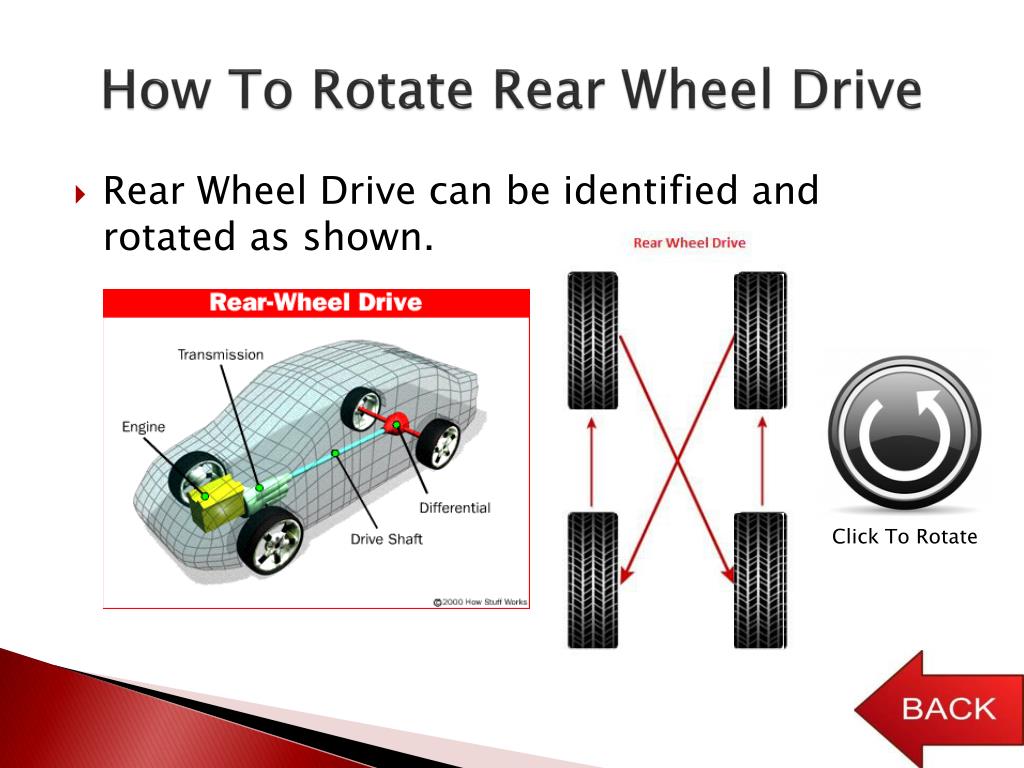
Learn more about how to choose a car jack.
Drivers often ask the question: why is the car's standard wheel key so inconvenient? The answer is simple: the length of the wrench is chosen so as not to exceed the tightening torque of the wheel nuts (100-110 Nm for passenger cars). But loosening stuck nuts often requires more force! In addition, the driver is different for the driver: for example, it will be difficult for a girl to tighten the wheel nuts to the nominal torque with a regular wrench. And don't say you haven't seen girls changing wheels.
In order not to have to kick the wrench or jump on it (which threatens to break the wheel studs), buy a reinforced wheel wrench: elongated or telescopic. When tightening nuts with such a wrench, you do not need to be zealous - remember the maximum tightening torque. And it will be much easier to unscrew the nuts.
When changing tires, don't forget to rotate them to ensure even wear.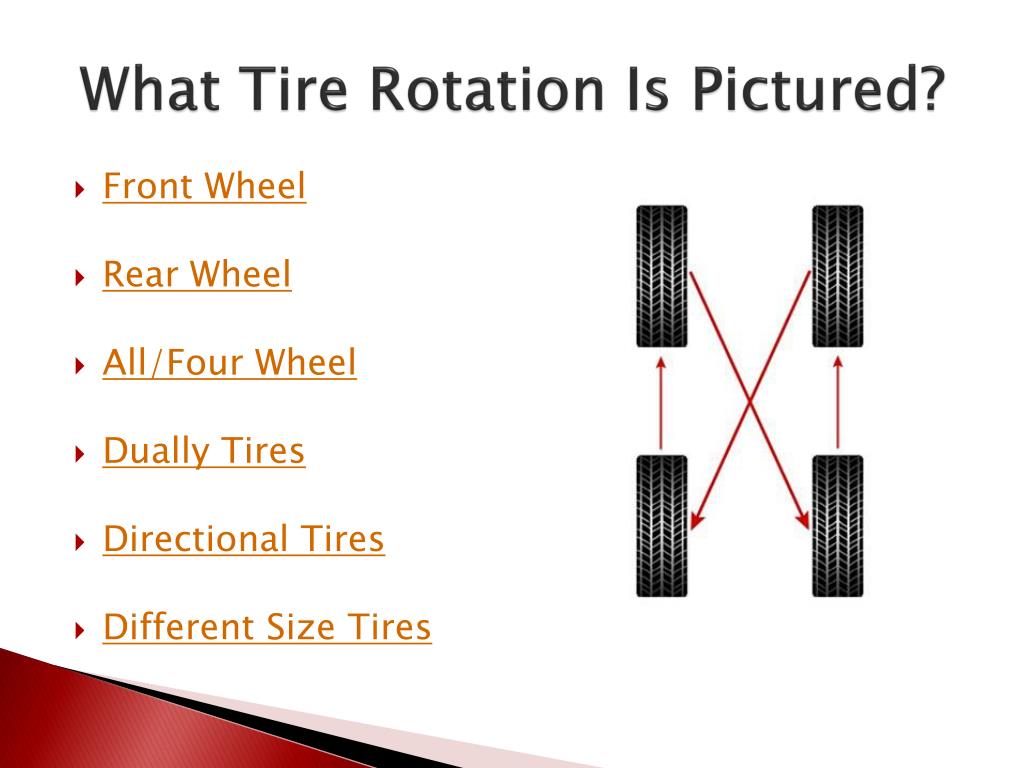 Usually tires with a large tread remain on the drive axle, because there they wear out more intensively. If the car is all-wheel drive, proceed from the design features of 4WD: the original front-wheel drive car with a connected “rear” wears out the front tires more, and the original rear-wheel drive car wears the rear tires.
Usually tires with a large tread remain on the drive axle, because there they wear out more intensively. If the car is all-wheel drive, proceed from the design features of 4WD: the original front-wheel drive car with a connected “rear” wears out the front tires more, and the original rear-wheel drive car wears the rear tires.
Tire rotation is more competently performed according to the instructions for the car - but for this you need to mark each of the wheels in advance (for example, with a marker on the inside of the disk). Examples of standard rotation patterns are shown below, and it is recommended to swap tires for even wear every 10,000 km.
On rear- and all-wheel drive vehicles, the front tires are moved to the rear axle diagonally (diagram A) or are changed crosswise (B). On machines with front-wheel drive, the opposite is true: the rear tires are moved diagonally forward (diagram C).
Tires with a directional tread pattern cannot be turned without overbeading.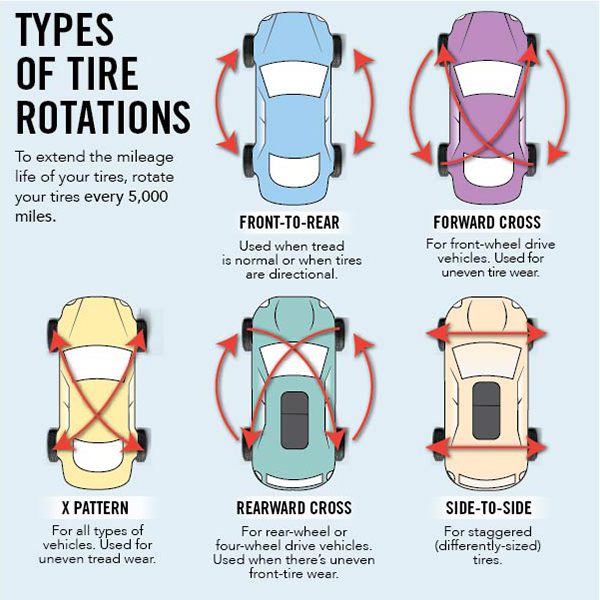 To rotate them without removing them from the disks, the front wheels are simply swapped with the rear wheels on each side of the car (Diagram D).
To rotate them without removing them from the disks, the front wheels are simply swapped with the rear wheels on each side of the car (Diagram D).
If the car is equipped with a full-size spare tire, not a spare tire, and you have bought a set of five new tires, be sure to include the spare tire in the rotation (diagrams E and F). This will allow you to use the kit longer and easily replace any of the main ones with a spare wheel in case of damage, because their wear will be the same. Thanks to this scheme, buying five tires is more profitable than four, due to the longer operation of the kit.
After removing the wheel, clean the wheel studs with a wire brush and brake cleaner. You also need to clean and grease the mating surface of the hub with graphite grease so that the rim does not stick to it. Graphite is chemically neutral, does not interact with nickel and chromium, therefore it does not oxidize and does not damage rims.
Whether it is necessary to lubricate the studs themselves is an open question: some automakers recommend it, while others directly prohibit it.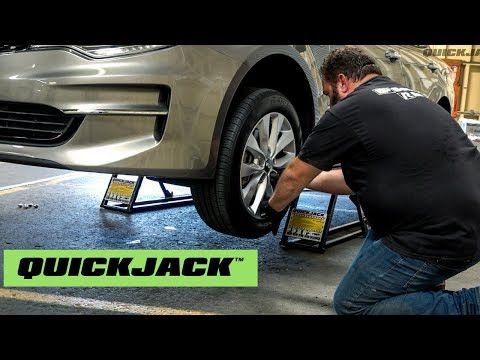 If you use standard wheel nuts with a cone, which attract the disk well, and observe the tightening torque, then there will be no harm from a small amount of graphite grease on the studs - most importantly, do not use other types of lubricants (for example, lithium) in this assembly.
If you use standard wheel nuts with a cone, which attract the disk well, and observe the tightening torque, then there will be no harm from a small amount of graphite grease on the studs - most importantly, do not use other types of lubricants (for example, lithium) in this assembly.
The wheel mounted on the hub is tightened crosswise (4 studs) or with an asterisk (5 and 6 studs), moving from each nut to the opposite one, and not to the next one - this way the even tightening is achieved.
The wheel nut tightening torque for most cars is 100-110 Nm, SUVs: 120-150 Nm. The exact parameters for tightening the nuts are indicated in the instructions for the car, and to withstand them, use a torque wrench. Of course, not all motorists have it. Without a “speaker”, be guided by the length of a regular wheelbarrow wrench and common sense: do not use the pipe as a lever and do not press on the wrench with your foot.
Tire pressure may change after six months of storage - be sure to check it after installing all the wheels using a manual pressure gauge.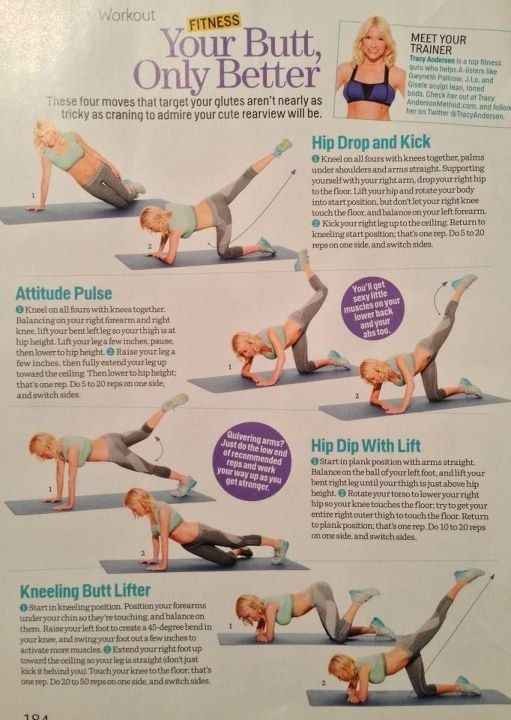 Pressure is always measured with cold tires. If the pressure in the tires is different, equalize it with a compressor, otherwise the car will pull to the side when driving.
Pressure is always measured with cold tires. If the pressure in the tires is different, equalize it with a compressor, otherwise the car will pull to the side when driving.
Learn more about tire pressure: how and why to measure it.
The removed set of wheels must be properly stored until the next season. This requires a well-ventilated, dry area, protected from the sun and precipitation - for example, an indoor heated parking lot. Private garages are not always suitable: if the roof leaks after every rain, then the humidity will destroy the paint on the rims in six months. Too dry air is the other extreme: rubber in such conditions ages intensively, cracks and cracks. Optimum humidity for wheel storage: 55-65% at 20-25°C. Such indicators are maintained all year round in the Tire Hotel Giperavto, a special warehouse for seasonal storage of wheels.
Tires and assembled wheels (tires on rims) are stored differently. Without disks, tires are stored vertically: they are placed in a row, periodically turning over to change the fulcrum. Tires on disks are placed in horizontal stacks of 2 wheels or suspended. Improper storage can lead to tire deformation and serious problems during further use.
Tires on disks are placed in horizontal stacks of 2 wheels or suspended. Improper storage can lead to tire deformation and serious problems during further use.
The main thing when changing tires yourself is not to rush anywhere: expect the process to take 1.5-2 hours. If you want to change the shoes of the car faster, welcome to the Hyperauto tire fitting with an appointment - they are guaranteed to do everything right.
Table of Contents:
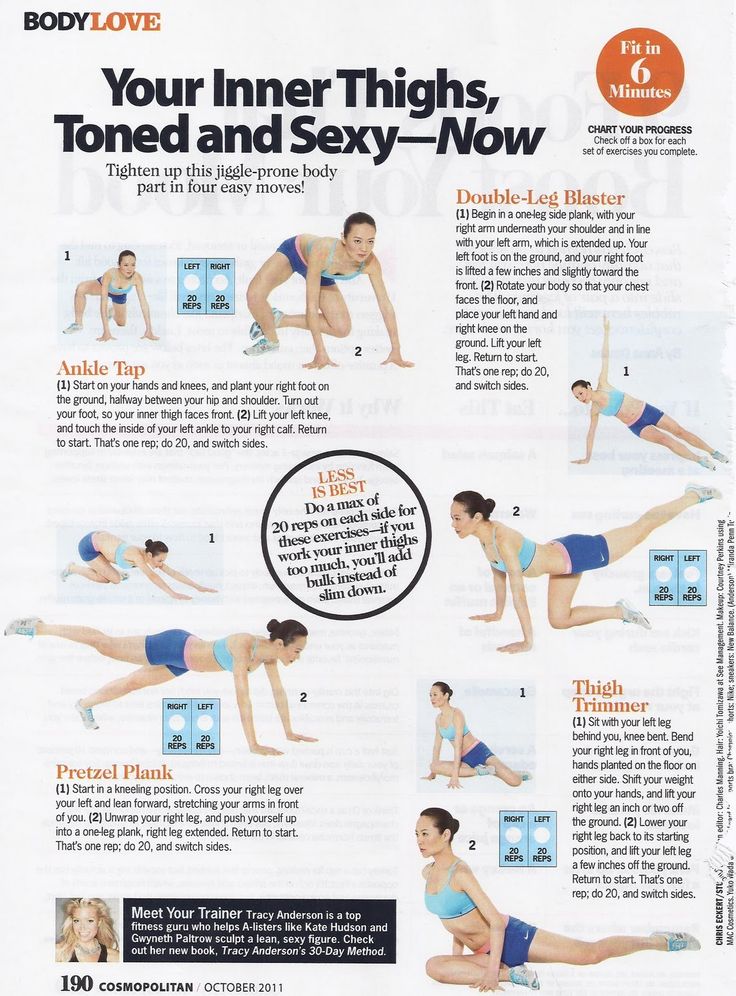 ..
.. Wheel rotation is like a physical exercise. Everyone knows to do it, but getting yourself to actually do it can be a challenge. While we can't really help you with fitness motivation, we have plenty of good reasons why you should swap tires every 5,000-13,000 miles.
Tire wear is inevitable when using a car. The location and extent of wear on a tire's contact patch depends on many factors, including the position of the tire on the vehicle. Keep in mind that each axle of a vehicle faces a different external force. For example, the front tires on a front wheel drive vehicle are regularly subjected to more intense stress than the rear tires. Thus, front tires on a front wheel drive vehicle typically experience accelerated wear compared to front tires on a rear or all wheel drive vehicle. Changing the wheels helps even out the wear on all four tires. If you leave the front tires uninterleaved on a front wheel drive car, they will wear out faster than the rears.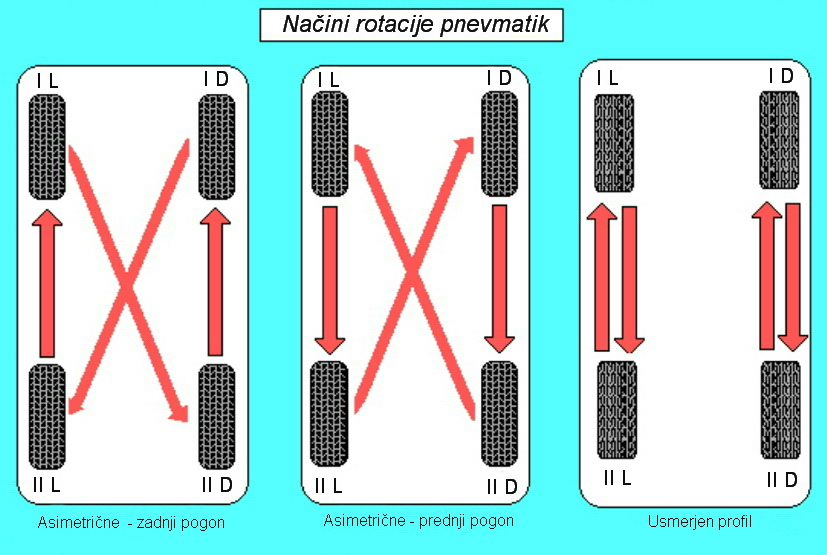 Without a proper check, you will end up with two front tires almost or completely at their maximum tread wear, and two rear tires with life remaining.
Without a proper check, you will end up with two front tires almost or completely at their maximum tread wear, and two rear tires with life remaining.
As a result, you will have to replace some tires prematurely. In some cases, while some of your tires may technically retain their remaining life, it will no longer make sense to pair them with any new tires with unworn tread. So you have to throw away not only worn tires, but also tires with remaining service life!
See also: Tire grip coefficient and factors affecting it
Summarizing all of the above, we can list the main reasons for rearranging tires in places:
Tires are absolutely essential to the efficiency and safety of a vehicle. Keeping your tires in good condition with rotation and other simple maintenance will help keep them wearing evenly which directly affects your vehicle's stability, driving predictability and makes it easier to maneuver safely throughout the life of your tires.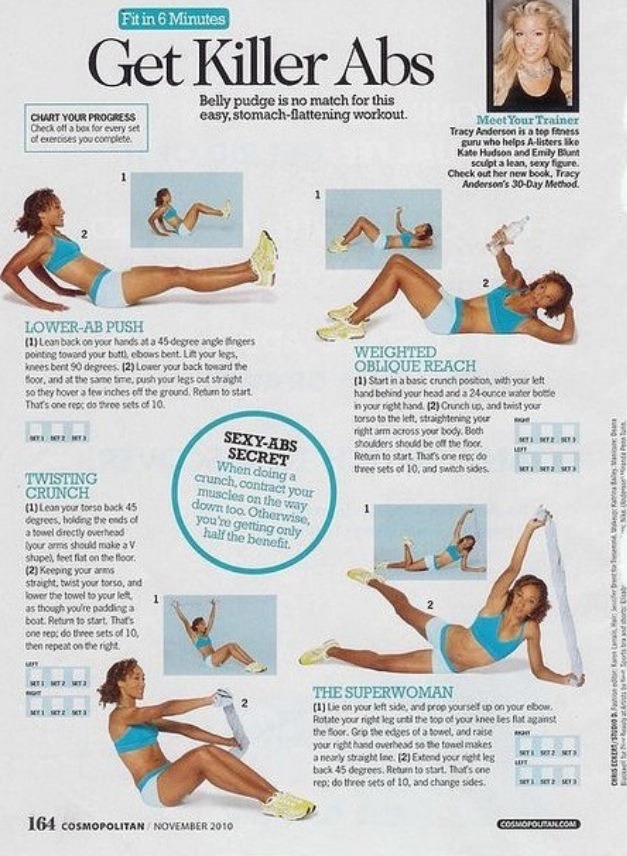 Tires in poor condition can cause the vehicle to vibrate.
Tires in poor condition can cause the vehicle to vibrate.
Remember: uneven tire wear can also affect the stability and handling of your vehicle. Swapping wheels is not only financially sensible, but it also helps to ensure the safety of your driving.
If tires are not rotated and maintained properly, you will likely lose not just a few hundred miles of their life, but thousands. The life of a tire can literally be cut off in the middle if you do not follow the rules for their alternation and do not take other necessary measures for their maintenance.
Tire manufacturers know that rotation is essential to realizing their full tire life. Tire mileage guarantees are most often set by tire manufacturers based on tire rotation. So if you never rotate tires and experience premature tire wear as a result, the manufacturer is unlikely to honor your warranty.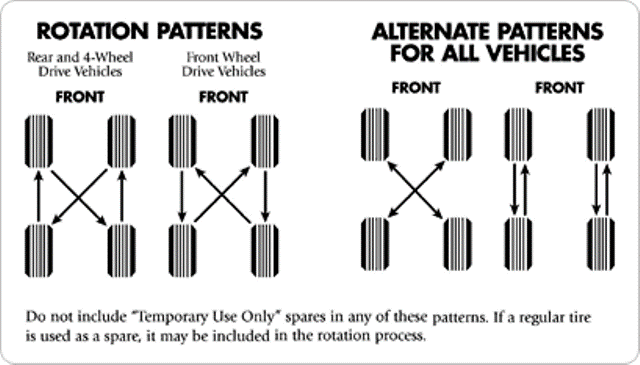 In other words, you'll be left on your own with a prematurely worn set of tires and a much more expensive replacement bill.
In other words, you'll be left on your own with a prematurely worn set of tires and a much more expensive replacement bill.
See also: Inflating tires with nitrogen - the pros and cons. What does filling tires with nitrogen give?
The good news is it's inexpensive. That small investment comes back to you in the form of long tire life and sustained vehicle safety and performance. In the long run, the cost of periodic tire rotation will be only a fraction of the amount you have to spend on buying new tires due to premature tire wear. It is also not uncommon for tire shops to offer discounted tire rotation services for regular customers, or from time to time offer to do it for free. So contact the tire shop that installed your tires first - in some cases, your tire rotation costs may be zero.
Helpful Hint: don't forget to label the wheels with the numbers and keep the tire rotation data and receipts. If you ever need to change tires under warranty, having these records will increase your chances of success.
If you ever need to change tires under warranty, having these records will increase your chances of success.
Are you used to doing everything yourself? Then you can rearrange the tires. If you can safely lift the car and remove the wheels, you can change the tires in your garage or on your driveway. In addition to the rearrangement pattern, you need to consider whether your tires are directional or non-directional, symmetrical or asymmetrical, and whether the tire pattern is staggered or square. If you are not sure about at least one of these points, it is better to entrust the work to a professional. Also consider that it is a smart move to put your tires in the hands of a competent professional from time to time. Tire specialists monitor their potential problems, identify misalignment and other issues that can affect tire condition/wear and vehicle performance.
For non-directional tires of the same size, you can use the diagonal swap pattern or move the front tires to the rear diagonal corner and the rear tires forward on the same side.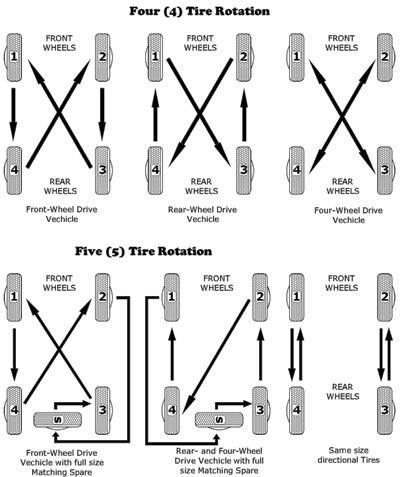
Also, due to the availability of modern tires, there is a need for 2 more rotation schemes:
Most modern cars are equipped with "stowaways" - this is not a full-size spare wheel, designed to temporarily replace a full-fledged wheel in order to somehow get to the nearest tire service. If you have a full-size spare tire, it should also be included in the swap plan.
If you have a full-size spare tire, it should also be included in the swap plan.
tire shift diagram for 4WD and 4WD vehicles Vehicles with dual rear wheels and non-directional tires may use one of the following rotation patterns:
Winter and studded tires also need to be rearranged so that they serve for a long time and behave adequately on the road.